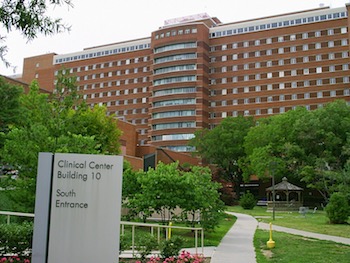Learn About NIH’s Draft Intramural Access Planning Policy
“The burdens of the NIH Access Plan Policy appear to be likely to create unacceptable commercial risks and uncertainty for potential private sector partners, which, in turn, will chill interest in forming the partnerships necessary to commercialize products and services based on federally-funded inventions.”
National Institutes of Health – Clinical Center (building #10) south entrance. Bethesda, Maryland USA. Photo by Christopher Ziemnowicz.
On May 22, 2024, the National Institutes of Health Office of Science Policy issued a Request for Information on its Draft NIH Intramural Research Program Policy: Promoting Equity Through Access Planning (“NIH RFI”). This RFI describes an NIH proposal to develop and implement a policy to promote access to products stemming from taxpayer-funded inventions under the Bayh Dole Act 35 USC 200: Policy and objective (house.gov). The comment period for this RFI closes July 22.
The objectives of the Bayh Dole Act include promoting the utilization of all inventions arising from federally supported research; encouraging participation of small business firms; collaboration between commercial concerns and nonprofit organizations; and commercialization and public availability of inventions made in the United States by United States industry and labor. 35 USC 200: Policy and objective (house.gov). The Bayh Dole Act addresses patented inventions owned solely by the Federal government as well as patents owned by individuals, small businesses, and nonprofit organizations (in which the government possesses a license).
The NIH RFI Access Plan Policy
The NIH RFI identifies a new “Access Plan” policy purporting to promote partnerships (licenses) that will “improve[] health for all” (hence “equity through access”) to “provide a return on taxpayers’ investment.” 2024-11188.pdf (govinfo.gov) at 45003-04. The Policy’s “all” refers to the whole of the U.S. population, as well as “populations in low- and middle-income countries. 2024-11188.pdf (govinfo.gov) at 45005.
NIH addresses its Policy to licensees of those who pursue federal funding of patents resulting in products involving solely medical and health applications such as vaccines, drugs, medical devices, or biologics for the prevention, diagnosis, or treatment of human disease, 2024-11188.pdf (govinfo.gov) at 45004. The NIH RFI also states that this RFI is limited to government-owned inventions, but it promises to address jointly-owned intellectual property in the future. Id. (I do not presume that the ownership of the inventions – federal government or joint ownership – will result in any differences in NIH proposed strategies of jointly-owned inventions, so my comments apply to each situation.)
The proposed Policy describes how licensees for commercializing such products must identify the steps of their Access Plan by including product affordability (including the ability of patient to afford the products, accounting for pricing structure, insurance, payment models and international price comparators), availability (whether products exist, are able to be manufactured, wide availability, and approvals across geographical regions), acceptability (including whether marketing resonates with end users, the products are tolerated, and effective delivery systems), and sustainability (whether the infrastructure enables the elements of access). 2024-11188.pdf (govinfo.gov) at 45004.
However, NIH states that its Policy will be “reasonable and not seek to force licensees into access obligations that obstruct commercial development or damage the viability and sustainability of a product in the market.” Id.
To this end, the NIH RFI requests public input on specific issues: (1) Promoting meaningful access approaches; (2) promoting transparency in the biomedical research enterprise and return on investment; (3) providing flexibility while achieving clear policy objectives; (4) helping licensees achieve access goals; (5) establishing licensee obligations depending on the stage of technology development; and (6) assessing policy impact. Id.
The NIH RFI Appendix further describes the required Access Plan in some detail. Theoretically, based in some way on responses to this RFI, NIH will develop guidance for “acceptable access plans” incorporating “strategies” including but not limited to:
- “Partnership with public health, non-profit, or patient advocacy organizations,” which “could include” not only R&D, regulatory approval, or sales and marketing partnerships, but also patent pools;
- “Addressing accessibility as a design objective” which “could include” conducting patient interviews, as well as making product or business choices to promote patient access;
- “Committing to sublicense relevant intellectual property and know-how,” which “could include” sublicensing to “manufacturers in countries or world regions,” committing to “license all [IP] and know-how needed to make a product” or “agreeing to sublicense relevant [IP] on a low-or no-royalty basis”;
- “Entering purchasing partnerships or commitment,” which “could include” agreeing to commit to supply product in a given market(s), agreeing to set aside a portion of manufactured product for donation or sale on a cost-plus basis;
- “Submitting additional commercialization plans targeted to other markets,” which “could include” offering product development timelines to develop formulations that meet a population’s unique needs or committing to a plan for developing suitable products for additional users; and
- “Promoting equitable access and affordability,” which “could include” a commitment to “keep prices in the U.S. equal to those in other developed countries; not raising costs above inflation; preparing tailored, culturally sensitive educational materials for a range of domestic and global patient populations.”
2024-11188.pdf (govinfo.gov) at 45005.
Additions to the Access Plan might include licensee requests for support or facilitation by NIH; “connections” to additional partner organizations “well-versed in access considerations,” and sharing of benefits such as access to publications; or international research collaboration.
NIH also suggests that there would be consideration of a waiver of the access planning provision “on a case-by-case basis.”
NIH RFI Access Plan vs. NIST Framework
This NIH proposal might seem familiar to the 2021 Notice of Proposed Rulemaking by the National Institute of Standards and Technology (“NIST NPR”) to amend various regulations and the 2023 NIST RFI regarding the promulgation of guidance for its proposed “framework” for funding agency application of the Bayh Dole march-in rights option (which Framework was identical to a proposed regulation in the 2021 NPR). Both NIST proposals feature requirements for owners or their licensees to address vast market pricing and cost issues.
Like the 2023 NIST Framework, the NIH RFI presumes that the “inventions” of the Bayh Dole Act are equivalent to the products resulting from inventions, and will require that stakeholders related to commercialization of federally-funded inventions be burdened with undue pricing and market analysis.
However, where the NIST Framework would apply the march-in provisions to all patented inventions supported by federal funding, the NIH Policy Access Plan is imposed solely on licensees that will promote commercialization of medicine and health-care products.
In addition, where the NIST Framework theoretically comes into play in contemplation of the government exercising march-in rights under a limited set of criteria, the NIH Access Plan is imposed as a pre-condition of funding, so the market analysis hardships imposed on the owner or contractor arise at a much earlier stage of the prospective commercialization process.
While the NIST Framework required owners and licensees to perform substantial and burdensome market analysis, the NIH Policy demands instead that the licensee essentially solve global social and logistics problems that have persistently evaded resolution by the largest entities in the world.
The burdens of the NIH Access Plan Policy appear to be likely to create unacceptable commercial risks and uncertainty for potential private sector partners, which, in turn, will chill interest in forming the partnerships necessary to commercialize products and services based on federally-funded inventions. Moreover, startups and small businesses and their licensees may lack the resources to produce the massive, globally applicable Access Plan called for by this RFI to maintain exclusive rights, which investors require to assume the risk.
NIH to NIST – KISS
The final lesson NIH learned from NIST was perhaps its most important: KISS – KEEP IT SECRET, STUPID. While NIST duly utilized a government regulations website that permitted review of all the submitted public comments () and garnered widespread commentary throughout and past the comment period, NIH is using a depository for public comment (Comment Form: Draft NIH Intramural Research Program Policy: Promoting Equity Through Access Planning – Office of Science Policy) that does not permit searching. Moreover, the NIH RFI gives no indication that public discussion would be valued, and states:
After the Office of Science Policy (OSP) has finished reviewing the responses, the responses may be posted to the OSP website without redaction.
So, perhaps OSP will post some or all of the responses, but perhaps they won’t. In any case, as the dearth of public commentary attests, NIH is not interested in discussion of the Policy.
Send Your Comments
It is unclear how the NIH Access Plan can fail to “obstruct commercial development or damage the viability and sustainability of a product in the market,” and if the public response to the 2021 and 2023 NIST publications (many thousands of posted comments) is any indication, the public will have a substantial amount to say to the NIH in response to this RFI. I have submitted a FOIA request for responsive comments to which I have received zilch from NIH. Please send me a copy of your NIH Access Plan Policy Comment!






